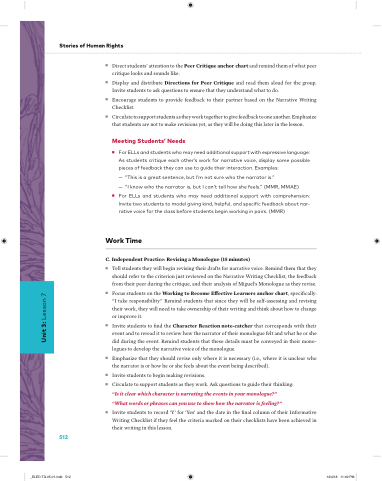Page 536 - EL Grade 5 Teacher Guide
P. 536
Stories of Human Rights
512
■ Direct students’ attention to the Peer Critique anchor chart and remind them of what peer critique looks and sounds like.
■ Display and distribute Directions for Peer Critique and read them aloud for the group. Invite students to ask questions to ensure that they understand what to do.
■ Encourage students to provide feedback to their partner based on the Narrative Writing Checklist.
■ Circulate to support students as they work together to give feedback to one another. Emphasize that students are not to make revisions yet, as they will be doing this later in the lesson.
Meeting Students’ Needs
■ For ELLs and udents who may need additional support with expressive language: As udents critique each other’s work for narrative voice, display some possible pieces of feedback they can use to guide their interaction. Examples:
— “This is a great sentence, but I’m not sure who the narrator is.”
— “I know who the narrator is, but I can’t tell how she feels.” (MMR, MMAE)
■ For ELLs and udents who may need additional support with comprehension: Invite two udents to model giving kind, helpful, and speci c feedback about nar- rative voice for the class before udents begin working in pairs. (MMR)
Work Time
C. Independent Practice: Revising a Monologue (15 minutes)
■
■
■
■
■ ■
■
Tell students they will begin revising their drafts for narrative voice. Remind them that they should refer to the criterion just reviewed on the Narrative Writing Checklist, the feedback from their peer during the critique, and their analysis of Miguel’s Monologue as they revise.
Focus students on the Working to Become E ective Learners anchor chart, speci cally: “I take responsibility.” Remind students that since they will be self-assessing and revising their work, they will need to take ownership of their writing and think about how to change or improve it.
Invite students to nd the Character Reaction note-catcher that corresponds with their event and to reread it to review how the narrator of their monologue felt and what he or she did during the event. Remind students that these details must be conveyed in their mono- logues to develop the narrative voice of the monologue.
Emphasize that they should revise only where it is necessary (i.e., where it is unclear who the narrator is or how he or she feels about the event being described).
Invite students to begin making revisions.
Circulate to support students as they work. Ask questions to guide their thinking: “Is it clear which character is narrating the events in your monologue?” “What words or phrases can you use to show how the narrator is feeling?”
Invite students to record ‘Y’ for ‘Yes’ and the date in the nal column of their Informative Writing Checklist if they feel the criteria marked on their checklists have been achieved in their writing in this lesson.
_ELED.TG.05.01.indb 512
12/4/18 11:49 PM
Unit 3: Lesson 7


